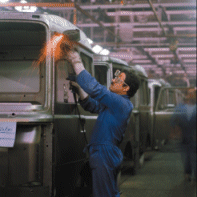Any new technology that focuses on improving profitability is usually first adopted by the retail industryhardly surprising considering the small margins that retailers often have to work with. But over the last couple of years, the automotive market has been catching on fast to the benefits. With the advent of greater transparency of car pricing across Europe, vehicle manufacturers are typically making much smaller profits on the sale of new cars, relying now on finance deals and aftermarket sales for much of their income.
 Improving competitiveness
Improving competitiveness
It is in this automotive aftermarket, the sector that provides replacement parts to motor dealers, and spares and accessories to motoring retailersbasically, anything that can be retrofitted to a vehiclethat the latest voice recognition technology can be applied most effectively to improve logistics and maintain competitiveness for automotive manufacturers.
Customers within the automotive aftermarket can be broadly classified into three groups: the original equipment manufacturers, independent motor factors, and major suppliers. Regardless of which category they fall into, they have one thing in commonvast warehouses holding many thousands of SKUs, all of which should ideally be available on demand, often for same day delivery.
speaking is faster and more natural than keying, there is minimal distraction and less wasted time, leading to productivity gains of at least 15 per cent."
In fact, a regime of three delivery cycles a day to main car dealers is not unusualthe car owner expects his car serviced on the agreed day, and any failure to achieve this due to non-availability of parts reflects negatively upon service levels, ultimately driving down profitability for the dealer and the car manufacturer. This of course places great demands upon the picking operation within the warehousespeed is crucial, and the potential for error increases accordingly. It is here that improvements in accuracy can produce the greatest return on investment.
Making complex operations easier
The automotive parts warehouse is characterised by a high volume of small orders. Many of the items to be picked are stored in bulk, so the additional complication of differing sizes and awkward shapes impacts on the ease and speed of picking. To further impede operations, certain high-value componentscar audio, for exampleare held in secure areas, while other items such as hazardous materials require specialised storage. On top of this, many items are multi-branded, bearing different part numbers, brand names or logos but having the same physical appearance. Never was there a greater need for maintaining eye contact with the job and having both hands free.
For these reasons suppliers are beginning to identify voice recognition technology as the way to go in automotive aftermarket distribution. In recent projects employing the market-leading voice system the pick-list and scanner have been effectively sidelined, leaving the operator to work hands-free, eyes-free.
Accuracy typically rises to greater than 99.9 per cent, and safety improves too, with up to 30 per cent fewer accidents occurring.
Warehouse staff need only a small, robust terminal, worn on a belt, and a lightweight headset to communicate in real-time with the warehouse management system (WMS). Commands are streamed from the WMS to the terminal on the pickers belt, directing him to the part of the warehouse where the item is to be picked; on reaching the appropriate rack he reads off some check digits to verify the location; the system then gives the number of items; the operator picks them and verbally confirms the number taken.
Boosting traceability
Component traceability is an issue in this market too. In the event of a product recall, original equipment manufacturers can be faced with significant costs, and the speed of retrieving data detailing which parts were fitted to which car is key to keeping those costs down. In the warehouse, this may mean introducing an additional stepthat of scanning a serial number bar code on an item when pickingbut even here, voice has its benefits, ensuring that this vital action is completed by prompting the picker to make the scan.
The result? As speaking is faster and more natural than keying, there is minimal distraction and less wasted time, leading to productivity gains of at least 15 per cent. Accuracy typically rises to greater than 99.9 per cent, and safety improves too, with up to 30 per cent fewer accidents occurring. Real-time visibility of the stock situation increases, with data from the mobile terminals being taken directly from point of action into the stock management system. Management now has a more accurate view of the stockholding, allowing the volume of safety stock to be gradually reduced as error rates drop.

Add a Comment
No messages on this article yet